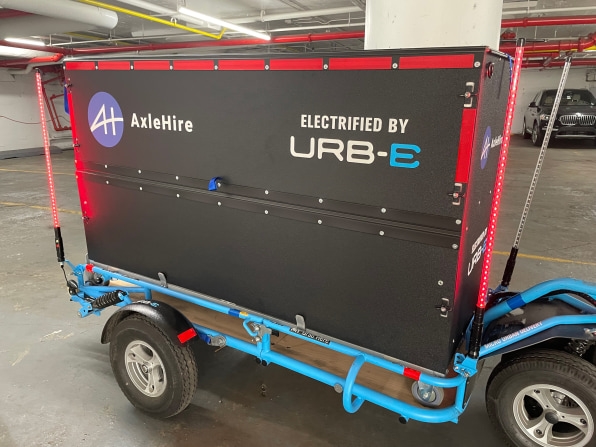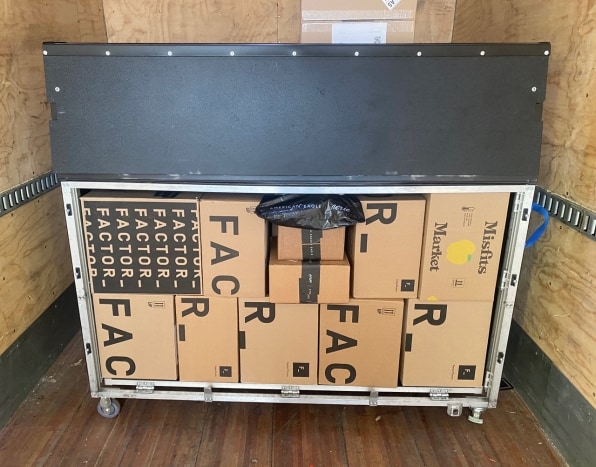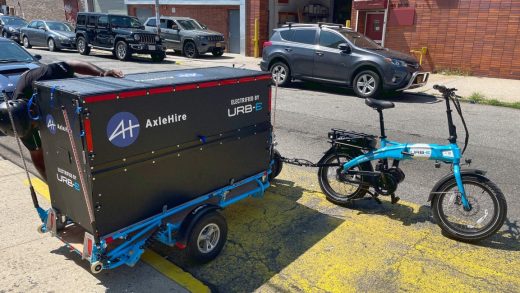E-bike package delivery is coming to L.A.
The final leg of a package’s journey to its destination, known as the “last mile,” is often the most inefficient of the entire trip. That’s because packages are usually divided into several different gas-fueled vehicles headed in different directions, often into traffic-filled city centers, decreasing delivery speed and increasing the environmental toll.
One company working to reduce these inefficiencies is urban logistics innovator, AxleHire. After running various pilots to evaluate solutions, its latest development is a larger-scale delivery service program in Los Angeles; opening four “microhubs” in the city, which will serve as bases for a new cargo model. Deliveries will leave each hub in containers pulled by electric bikes. The aim: to increase delivery loads, reduce time stuck in traffic, and cut carbon emissions.

The program will use a network of cargo-carrying e-bikes, called URB-E, with the goal of achieving the “containerization of the last mile,” says URB-E cofounder and chief technology officer Sven Etzelsberger, a former engineer for Ford and Porsche. The e-bikes simply hitch a trailer loaded with a pre-packed container. “We believe that we can bring the same efficiencies to the last mile that these containers brought to global trade back in the ’50s and ’60s,” he says. Containers act as a direct replacement for vans or trucks, negating the messy need to fill vehicles with individual parcels. “That’s really the beauty of containerization,” he says.
The containers are expansive, at 72 cubic feet. “It’s almost the size of a smaller-size wardrobe,” Etzelsberger says. Still, that’s less spacious than a truck. But, AxleHire CEO Adam Bryant explains, time is just as important a factor as volume. When there are multiple smaller items to deliver, like envelopes or polybags, a truck sitting in traffic is likely to deliver fewer than an e-bike flying past stopped cars in the bike lane. What’s more, URB-E reports saving 95% in carbon emissions versus a diesel van, and even 65% to 70% compared to an electric van.
The partnership has established four microhubs: Long Beach is already open; next are Downtown L.A., Glendale, and Santa Monica. Here’s how it works: Clients—including meal-kit purveyors like Hello Fresh, retailers like American Eagle Outfitters, and other e-commerce fulfillment companies like Deliverr—bring their packages to AxleHire’s central sortation center in La Palma, Orange County. That’s where AxleHire uses its algorithms to methodically sort packages into specific containers for different routes.

Each day, the containers are loaded into a single truck and shipped in bulk to the microhubs, which can be as simple as parking lots—a place to store equipment overnight, and for trucks to offload the containers. Then each container is hooked up to an e-bike, and the delivery rider starts their route, dropping off parcels at homes and offices.
AxleHire has tested several other transport solutions, including cargo bikes, electric vehicles and pallets, as well as food trucks in a Seattle pilot with the University of Washington. But, URB-E won out for sheer scalability and has been partnering since last August for deliveries in New York City, proving a sixfold reduction in traffic and threefold reduction in cost versus electric vans. They’re also more feasible for at-scale operations than small sidewalk robots.
Assessing early reactions from the Long Beach hub operation, Etzelsberger reports residents appreciate the replacement of noisy, congesting vehicles with a sustainable solution. “It’s been amazing to see the reaction of people in the neighborhood,” he says, “when they’re walking their dogs, and they see the URB-E going by.”
Fast Company , Read Full Story
(22)



